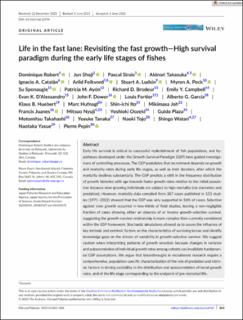| dc.contributor.author | Robert, Dominique | |
| dc.contributor.author | Shoji, Jun | |
| dc.contributor.author | Sirois, Pascal | |
| dc.contributor.author | Takasuka, Akinori | |
| dc.contributor.author | Catalán, Ignacio A. | |
| dc.contributor.author | Folkvord, Arild | |
| dc.contributor.author | Ludsin, Stuart A. | |
| dc.contributor.author | Peck, Myron A. | |
| dc.contributor.author | Sponaugle, Su | |
| dc.contributor.author | Ayón, Patricia M. | |
| dc.contributor.author | Brodeur, Richard D. | |
| dc.contributor.author | Campbell, Emily Y. | |
| dc.contributor.author | D'Alessandro, Evan K. | |
| dc.contributor.author | Dower, John F. | |
| dc.contributor.author | Fortier, Louis | |
| dc.contributor.author | García, Alberto G. | |
| dc.contributor.author | Huebert, Klaus B. | |
| dc.contributor.author | Hufnagl, Marc | |
| dc.contributor.author | Ito, Shin-ichi | |
| dc.contributor.author | Joh, Mikimasa | |
| dc.contributor.author | Juanes, Francis | |
| dc.contributor.author | Nyuji, Mitsuo | |
| dc.contributor.author | Oozeki, Yoshioki | |
| dc.contributor.author | Plaza, Guido | |
| dc.contributor.author | Takahashi, Motomitsu | |
| dc.contributor.author | Tanaka, Yosuke | |
| dc.contributor.author | Tojo, Naoki | |
| dc.contributor.author | Watari, Shingo | |
| dc.contributor.author | Yasue, Naotaka | |
| dc.contributor.author | Pepin, Pierre | |
| dc.date.accessioned | 2023-11-21T13:24:48Z | |
| dc.date.available | 2023-11-21T13:24:48Z | |
| dc.date.created | 2023-09-04T10:05:14Z | |
| dc.date.issued | 2023 | |
| dc.identifier.citation | Fish and Fisheries. 2023, 24 (5), 863-888. | |
| dc.identifier.issn | 1467-2960 | |
| dc.identifier.uri | https://hdl.handle.net/11250/3103867 | |
| dc.description.abstract | Early life survival is critical to successful replenishment of fish populations, and hypotheses developed under the Growth-Survival Paradigm (GSP) have guided investigations of controlling processes. The GSP postulates that recruitment depends on growth and mortality rates during early life stages, as well as their duration, after which the mortality declines substantially. The GSP predicts a shift in the frequency distribution of growth histories with age towards faster growth rates relative to the initial population because slow-growing individuals are subject to high mortality (via starvation and predation). However, mortality data compiled from 387 cases published in 153 studies (1971–2022) showed that the GSP was only supported in 56% of cases. Selection against slow growth occurred in two-thirds of field studies, leaving a non-negligible fraction of cases showing either an absence of or inverse growth-selective survival, suggesting the growth-survival relationship is more complex than currently considered within the GSP framework. Stochastic simulations allowed us to assess the influence of key intrinsic and extrinsic factors on the characteristics of surviving larvae and identify knowledge gaps on the drivers of variability in growth-selective survival. We suggest caution when interpreting patterns of growth selection because changes in variance and autocorrelation of individual growth rates among cohorts can invalidate fundamental GSP assumptions. We argue that breakthroughs in recruitment research require a comprehensive, population-specific characterization of the role of predation and intrinsic factors in driving variability in the distribution and autocorrelation of larval growth rates, and of the life stage corresponding to the endpoint of pre-recruited life. | |
| dc.language.iso | eng | |
| dc.title | Life in the fast lane: Revisiting the fast growth—High survival paradigm during the early life stages of fishes | |
| dc.title.alternative | Life in the fast lane: Revisiting the fast growth—High survival paradigm during the early life stages of fishes | |
| dc.type | Peer reviewed | |
| dc.type | Journal article | |
| dc.description.version | publishedVersion | |
| dc.source.pagenumber | 863-888 | |
| dc.source.volume | 24 | |
| dc.source.journal | Fish and Fisheries | |
| dc.source.issue | 5 | |
| dc.identifier.doi | 10.1111/faf.12774 | |
| dc.identifier.cristin | 2171984 | |
| cristin.ispublished | true | |
| cristin.fulltext | original | |
| cristin.qualitycode | 2 | |
